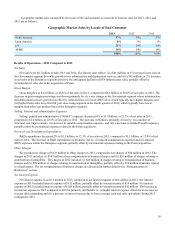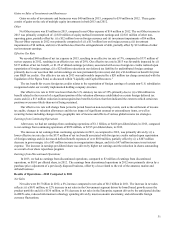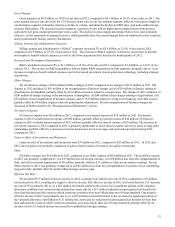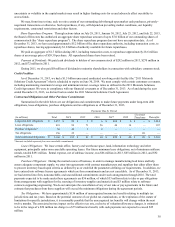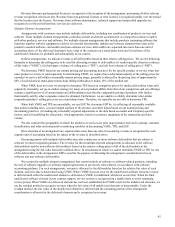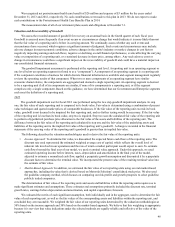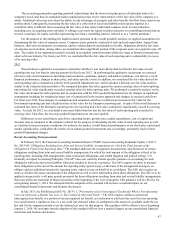Motorola 2013 Annual Report Download - page 42
Download and view the complete annual report
Please find page 42 of the 2013 Motorola annual report below. You can navigate through the pages in the report by either clicking on the pages listed below, or by using the keyword search tool below to find specific information within the annual report.40
Adequate Internal Funding Resources
We believe that we have adequate internal resources available to fund expected working capital and capital expenditure
requirements for the next twelve months as supported by the level of cash, cash equivalents and short-term investments in the
U.S. and the ability to repatriate funds from foreign jurisdictions.
Other Contingencies
Potential Contractual Damage Claims in Excess of Underlying Contract Value: In certain circumstances, our businesses
may enter into contracts with customers pursuant to which the damages that could be claimed by the other party for failed
performance might exceed the revenue we receive from the contract. Contracts with these types of uncapped damage
provisions are fairly rare, but individual contracts could still represent meaningful risk. There is a possibility that a damage
claim by a counterparty to one of these contracts could result in expenses to us that are far in excess of the revenue received
from the counterparty in connection with the contract.
Indemnification Provisions: In addition, we may provide indemnifications for losses that result from the breach of
general warranties contained in certain commercial, intellectual property and divestiture agreements. Historically, we have not
made significant payments under these agreements, nor have there been significant claims asserted against us. However, there
is an increasing risk in relation to intellectual property indemnities given the current legal climate. In indemnification cases,
payment by us is conditioned on the other party making a claim pursuant to the procedures specified in the particular contract,
which procedures typically allow us to challenge the other party’s claims. In some instances we may have recourse against
third-parties for certain payments made by us. Further, our obligations under divestiture agreements for indemnification based
on breach of representations and warranties are generally limited in terms of duration, typically not more than 24 months, and
for amounts not in excess of a percentage of the contract value.
Legal Matters: We are a defendant in various lawsuits, claims and actions, which arise in the normal course of business.
In the opinion of management, the ultimate disposition of these matters will not have a material adverse effect on our
consolidated financial position, liquidity or results of operations. However, an unfavorable resolution could have a material
adverse effect on our consolidated financial position, liquidity or results of operations in the periods in which the matters are
ultimately resolved.
Significant Accounting Policies
Management’s Discussion and Analysis of Financial Condition and Results of Operations discusses our consolidated
financial statements, which have been prepared in accordance with U.S. generally accepted accounting principles. The
preparation of these financial statements requires management to make estimates and assumptions that affect the reported
amounts of assets and liabilities and the disclosure of contingent assets and liabilities at the date of the financial statements, as
well as the reported amounts of revenues and expenses during the reporting period.
Management bases its estimates and judgments on historical experience, current economic and industry conditions and on
various other factors that are believed to be reasonable under the circumstances. This forms the basis for making judgments
about the carrying values of assets and liabilities that are not readily apparent from other sources. Actual results may differ
from these estimates under different assumptions or conditions. Management believes the following significant accounting
policies require significant judgment and estimates:
—Revenue recognition
—Inventory valuation
—Income taxes
—Restructuring activities
—Retirement benefits
—Valuation and recoverability of goodwill
Revenue Recognition
Net sales consist of a wide range of activities including the delivery of stand-alone equipment or services, custom design
and installation over a period of time, and bundled sales of equipment, software and services. We enter into revenue
arrangements that may consist of multiple deliverables of our products and services due to the needs of our customers. We
recognize revenue when persuasive evidence of an arrangement exists, delivery has occurred, the sales price is fixed or
determinable, and collectability of the sales price is reasonably assured. We recognize revenue from the sale of equipment,
equipment containing both software and nonsoftware components that function together to deliver the equipment’s essential
functionality, and services in accordance with general revenue recognition accounting principles. We recognize revenue in


